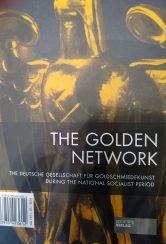Chapter extracts from: The Golden Network – The Deutsche Gesellschaft für Goldschmiedekunst During the National Socialist Period
© 2019 Societäts-Verlag, Frankfurt, authors, translator. ISBN: 978-3-95542-361-2 
The Objectives of the DGFGK – Art Promotion and Sales Enhancement by means of Advertising
Ferdinand R. Wilm had made statements concerning the society’s objectives in various lectures on different occasions. For example, on May 7, 1933 he explained: “[…] Right from the start, the society’s founders had a twofold objective in mind. First, to cultivate and promote creative goldsmithery in Germany; second, to stimulate art-historical research into artistic goldsmithery. Thus, firmly rooted in the soil of the present day, the society is looking both backward into the past and forward into the future […].”[1] The intention was not to create any “[…] professional organization”, but, rather, the society was to be “from a loftier standpoint, the cultural link between the professional organizations and the cultural creativity of the nation”.[2] These objectives of the DGfGK were formulated in § 1 of the articles of association of 1932. “The Deutsche Gesellschaft für Goldschmiedekunst has as its objective the promotion of art-historical research into artistic goldsmithery and the elevation and cultivation of artisanal goldsmithery in Germany.”[3] However, these two generally formulated objectives now yielded specific tasks on the part of the association, which were likewise listed in ten points in § 1 of the articles of association.[4]
[1] Lecture by Ferdinand R. Wilm in Rome on May 7, 1933 about the objectives of the Deutsche Gesellschaft für Goldschmiedekunst, p. 1, in: archive of the Gesellschaft für Goldschmiedekunst, Hanau [translated by Alexandra Cox].
[2] Eberlein, Kurt Karl: Goldschmiedekunst als Kulturpolitik, p. 7. [translated by Alexandra Cox].
[3] Articles of association of the Deutsche Gesellschaft für Goldschmiedekunst from the year 1932, in: Amtsgericht Hanau, associations register no. 1049, Deutsche Gesellschaft für Goldschmiedekunst, Berlin, p. 4. [translated by Alexandra Cox].
[4] The ten points were: To support the public collections in their collection activity; To awaken general interest in artistic goldsmithery by organizing exhibitions; To promote the publication of exhibition catalogs, magazines, books, illustrated photographic material; To bring about the full recording and systematic publication of German art treasures under appropriate use of existing preliminary works; To exercise an influence over further population groups through art history lectures and demonstrations of various kinds; To produce the link among state and municipal institutions such as museums, schools, exhibition offices, associations, organizations, guilds that operate artisanally or industrially, such as all the branches that are directly or indirectly associated with artistic goldsmithery; To work toward the maintenance of institutions and connections to suitable positions in Germany and abroad; To distinguish special works in the field of scientific research, outstanding artistic achievements, or the creation of valuable professional organizations through awarding of medals and honorary gifts; To advocate for the setting up of travel grants and advanced training opportunities for representatives of the new artistic goldsmithery; To ensure that artistic goldsmithery is granted the cultivation and appreciation to match its significance and history. Cf. Articles of Association of the Deutsche Gesellschaft für Goldschmiedekunst from 1932, in: Amtsgericht Hanau, associations’ register no. 1049, Deutsche Gesellschaft für Goldschmiedekunst, Berlin, sheet 4ff.
The advent of National Socialism brought difficulties in implementing these objectives: click on the poppy for more:![]()
